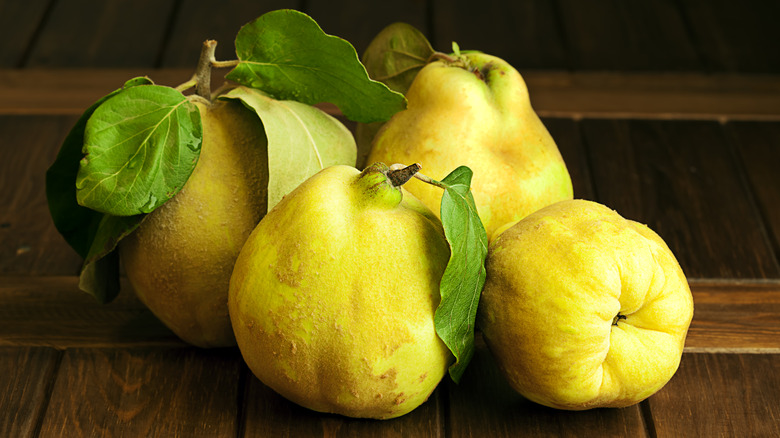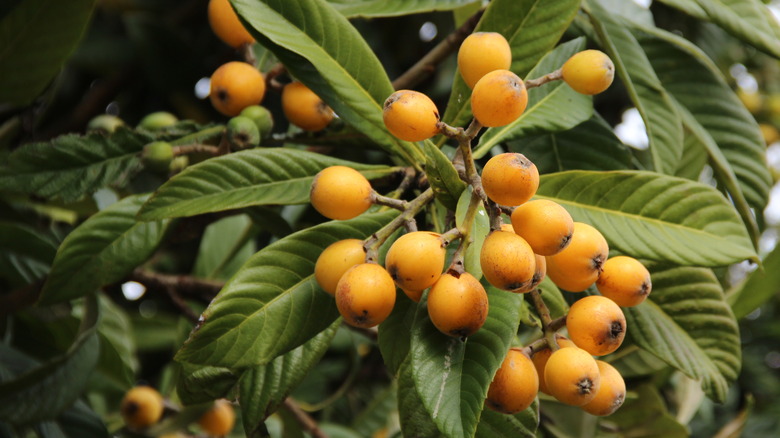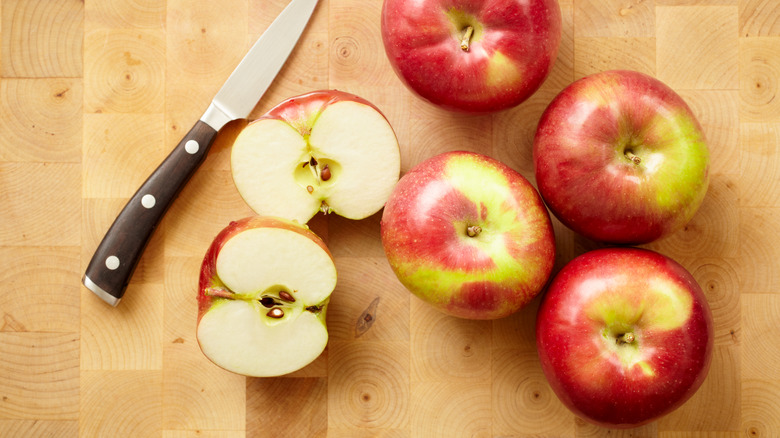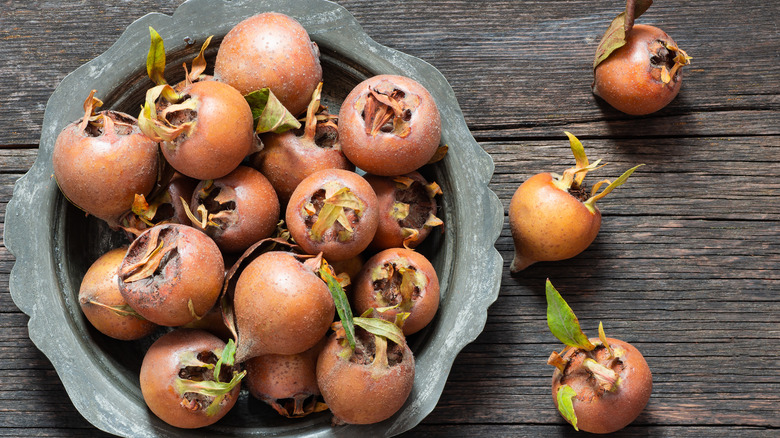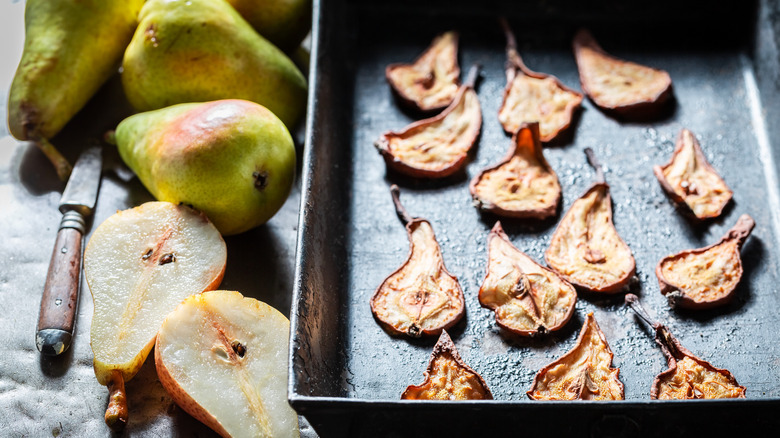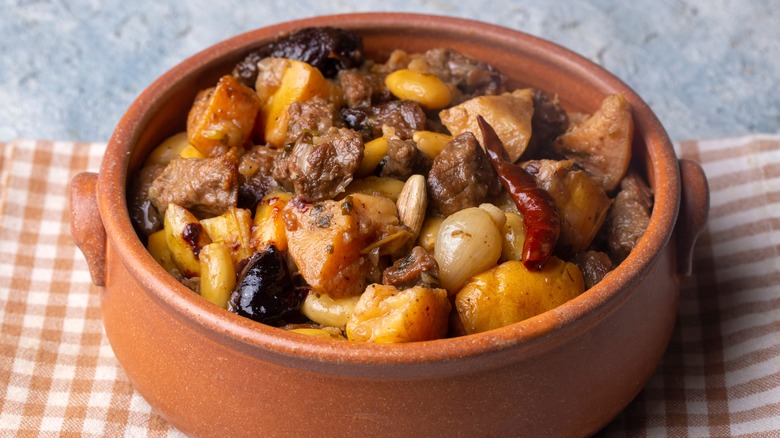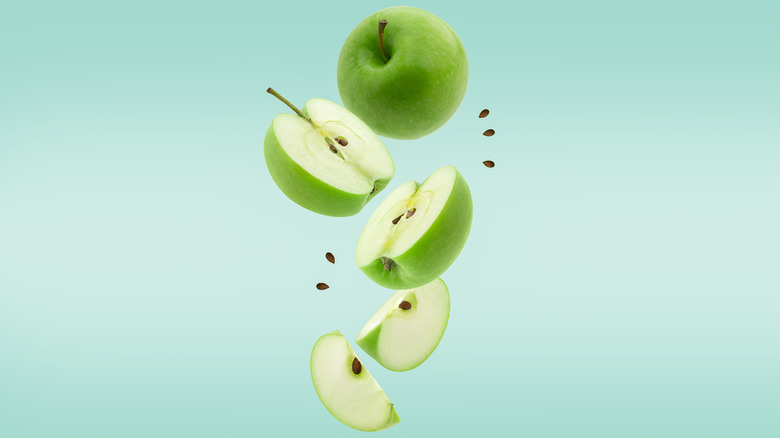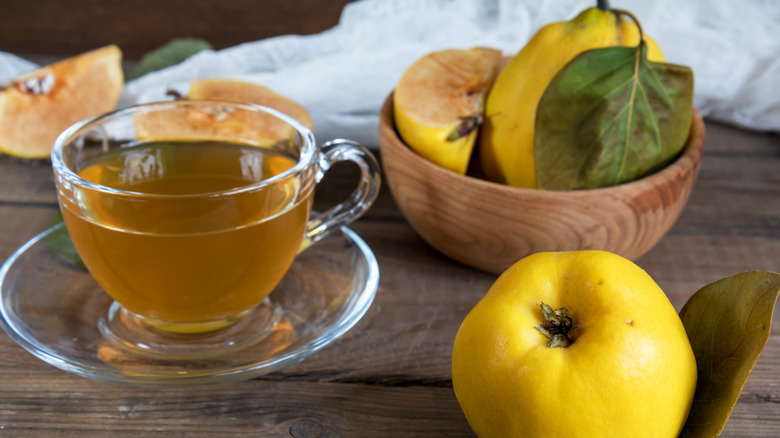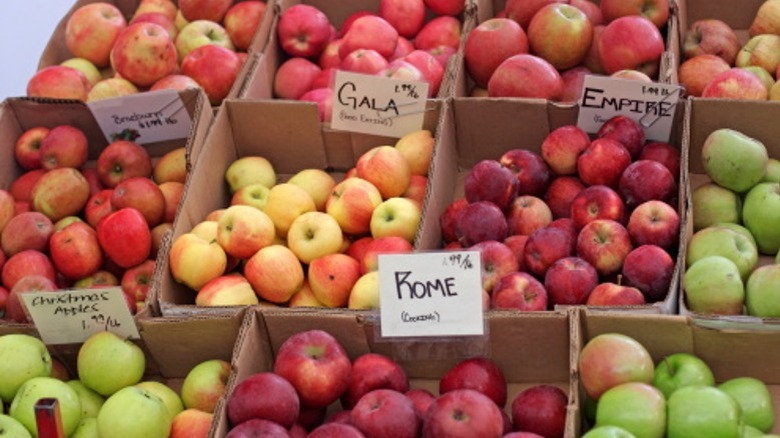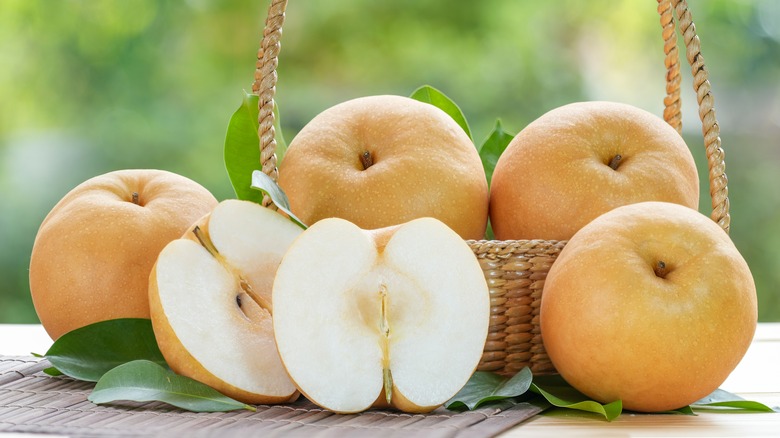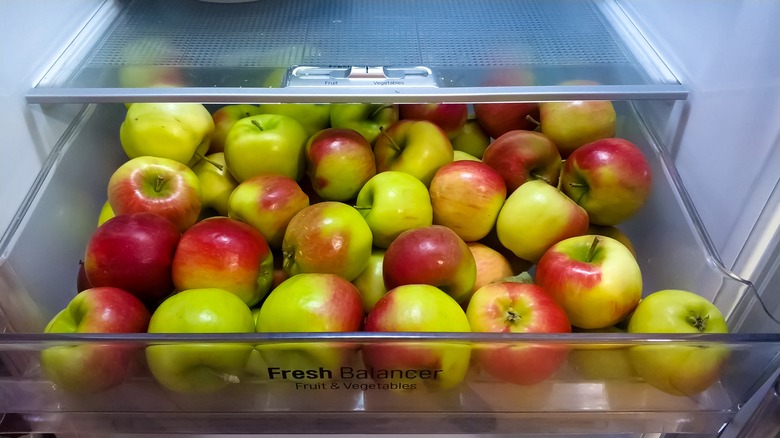What Are Pomes And How Are They Related To Other Fruits?
Did you know that apples and pears are a part of the rose family? Within the rose family, or Rosaceae, there is a group of plants called the Malinae, which produce pomes. Pome fruits are identifiable by their hard inner seed core surrounded by edible flesh and covered in skin. The most popular types of pomes are apples and pears, but there are plenty of others, too.
Each type of pome fruit has a unique flavor and texture, so the designation of pome has less to do with how the fruit tastes and more to do with how it grows. Trees that grow pomes can be found all over the world and are deciduous, meaning they shed their leaves in the winter. Pomes vary in size, from small fruits resembling berries up to the size of your fist.
Pomes aren't the only fruit in the rose family, though. Prunus is another genus of rose plants, commonly known as stone fruits like apricots, peaches, plums, and cherries. Raspberries, blackberries, and other bramble fruits are also in the rose family as part of the genus Rubus. Who knew roses had such varied flavors?
Varieties of pomes
Pomes include apples, pears, Asian pears, loquats, medlars, and quinces. In warmer climates, you might find loquats, a soft orange fruit native to China and popular in Japan. Relatively small, loquats grow in clusters of up to 25 and have a history of medicinal use. Don't forget the sweet-scented and golden-yellow skinned quinces, which were possibly the original golden apples from the story of the Trojan War in Greek mythology. Originally from the Caucasus region to the east of the Black Sea, these fruits are now found worldwide. Asian pears (which are a separate fruit, not a variety of pear) are found worldwide but are particularly popular in their namesake of Asia.
Last but not least, we have medlars, which have fallen out of favor over the past century but were at one point quite popular. They were even referenced in "Romeo and Juliet" as part of a fruit-themed sexual innuendo. There are more pomes out there, but these are the most common ones that are grown for consumption. Less common varieties include rowans, hawthorns, crab apples, and toyons.
What do pomes taste like?
Although pomes share some similarities, each fruit has its own specific flavor profile. Even within a particular fruit, there are deeper varieties that can be incredibly diverse. Take apples for example. There are over 7,500 varieties of apples grown around the world, each with a unique taste. That said, apples are generally crisp, mildly sweet, and astringent. Pears have softer flesh than apples and, when ripe, they can be deliciously juicy. Pears tend to have a fresh sweetness to them, though some varieties are more tart. Asian pears have the crunch of an apple with the taste of a European pear.
Loquats are highly unique. They are soft like pears and have a similar flavor profile to stone fruits like apricots and peaches, sometimes even being compared to tropical fruits like mangos. While Quinces can be eaten raw, it isn't very common, which is unusual for pomes. Raw quince is technically edible but tastes overly bitter and sour. Quince is almost always cooked until softened, resulting in a light-pink piece of fruit with a taste of floral vanilla. When properly prepared, medlars have the taste of apple butter sprinkled with cinnamon.
How to eat pomes
Most pomes can be eaten fresh off the vine. Bite into them whole, slice them into bite-sized pieces, or chop them into chunks; no preparation required. Other pomes, like quinces and medlars, take some know-how to get them into the right state for enjoyable eating. Quinces are hardly ever eaten fresh. The taste is bitter, the skin is tough, and the flesh is hard. Eating quince raw is an acquired taste. If you want to enjoy eating a quince, boiling it with sugar is a great way to bring out the sweet, fruit-forward flavor hidden inside.
Medlars are even more complicated as they require a process called bletting. You can think of bletting as the process of over-ripening. Even when ripe, medlars are hard and inedible. At the time of harvest, they are taken to a cool, dry place and allowed to rest for several weeks until they become over-ripe. At this point, their nearly rotten flesh has finally become soft, delicious, and ready to eat. The disappearance of medlars from our diet is in no small way due to the problems associated with bletting. Not only is it time-intensive, a bletted medlar simply doesn't look as appealing as a freshly waxed apple in the produce aisle. But, if you ever get the chance to try a bletted medlar, there's a chance you may discover your new favorite fruit.
Fresh pomes vs. dried pomes
The debate over whether fresh fruit is healthier than dried fruit is still in full swing, but humans have been drying fruit for millennia, and pomes are no exception. Like all dried fruit, dried pomes will have a higher sugar content and more calories, but they are still a great source of fiber and nutrients. Whether or not dried fruit is a good addition to your diet will depend on what else you're already eating and your overall state of health, but, generally speaking, dried pomes can be a great way to reach your daily recommended intake of two cups of fruit.
You can probably find dried apples and pears at your local grocery store, which is convenient, but you can also dry fruit at home. For less common pomes, drying at home may be your only option, but it's well worth the trouble. You can dry quinces and loquats in a dehydrator or in the oven, extending their shelf life and leaving you with a portable fruit snack. You can also turn pomes into fruit leather.
Snacks aren't the only use for dried pomes, though. Dried quince is a style of tea popular in both Korea and the Middle East, particularly in Iran. Due to the bletting process, medlars are the only pome which won't dry well. Goji berries are sometimes called dried red medlars, but they are not actually medlars or pomes at all, so don't get the two confused.
How to cook with pomes
One popular way of cooking pomes is to turn them into jams and jellies. In fact, the word marmalade comes from the Portuguese word for quince: marmelo. But, there is a whole world of pome cooking to explore. Just remember that the seeds of pomes are not edible, and neither are their cores, so remove those before cooking. For most pomes, the skin is edible but optional. However, medlars need to be peeled before being eaten or cooked.
Apples are a highly versatile ingredient you can incorporate into both sweet and savory dishes. They make great additions to salads, can be the star of the show in apple pie, or can be cooked into apple butter to be spread on a slice of bread. Pears are just as versatile despite their extra sweetness. They make a surprisingly good companion to meat, can be enjoyed in cakes or pies, and can make for a phenomenal pasta dish if done right.
Quinces are also adaptable. Try khoresh-e beh, a traditional Persian quince stew, or mix two pomes together for an apple and quince pudding. Loquats are delicious enough when fresh, but if you want to include their wholly unique flavor in a recipe, try making loquat chutney or loquat upside-down cake. After bletting, medlars make for fantastic additions to pastries but are particularly known for medlar cheese, which would make a great addition to a charcuterie board.
Are pomes poisonous?
Pomes are delicious, but before you get excited and eat every last piece, there's something you should know: Pome seeds are not edible. The flesh of the fruit is safe to eat, but the seeds contain amygdalin, which, when chewed, gets released into the body as cyanide. In high enough doses, cyanide is lethal. In fact, cyanide has been used as a deadly poison for centuries. If you accidentally eat one or two seeds, it is highly unlikely that you will die, but that doesn't mean you should test your luck. They taste terrible, anyway.
Although you would need to eat a large number of pome seeds to become dangerously sick, they can cause headaches, anxiety, and dizziness in smaller quantities. If you are experiencing any of these symptoms, consider going to a doctor. Pome seeds have been used medicinally in the past, but this was usually an external application not intended for ingestion, like a salve. It's possible to find ground-up pome seeds sold as a natural remedy, but just because they are being marketed as healthy doesn't mean that they are. The seeds are toxic — end of story.
Do pomes make you sleepy?
Apples contain a small amount of melatonin, the hormone your brain produces in response to darkness, commonly taken as a sleep supplement. So, it makes sense that some people wonder if apples are better eaten at night. For better or worse, there isn't enough melatonin in apples to affect the body. So, no, apples don't make you sleepy.
Loquats are known to have a sedative effect if you eat enough of them, though the science behind why this might be is still in its infancy. Quince tea is also a popular bedtime tea, especially teas that use the seeds of the quince. Fresh quince is not known for any sedative properties.
Pears and medlars do not have sedative qualities, and their high sugar content paired with their high fiber is more likely to wake you up than calm you down. Apples, pears, quinces, and medlars are better eaten in the daytime if you have trouble sleeping.
Where to buy pomes
Apples, pears, and Asian pears are typically the most readily available pomes. You will almost certainly find them in the produce aisle of any grocery store you go to. If you want to try less common pome varieties, consider searching out a local orchard and picking them yourself when they're in season.
Other pomes like quince, loquats, and medlars will be a lot more challenging to find in grocery stores. It's worth going to your local farmers market to see if anyone is selling them, or you can try checking international shops, like Asian and Latin markets. If you aren't having any luck, start asking around. Ask the vendors at the farmers market, your friends, or your coworkers if they know anyone who grows the kind of pome you're looking for. It may take some digging, but they aren't so uncommon that they're impossible to find. If all else fails, there are options to purchase them online. Some pomes can be quite soft, so they may get bruised in the process of shipping.
Nutritional information about pomes
Pomes are an excellent source of nutrients with a relatively low calorie count. Lots of nutrients are stored in the skin, so if you want to maximize the health benefits, don't peel the skin. Apples are a great source of fiber, vitamin C, and antioxidants. Their high water content also keeps you full for longer, which is helpful with weight loss. Pears are another great source of fiber but also have certain plant compounds that are good for heart and eye health. Similarly, Asian pears are high in fiber (are you seeing a trend here?) but are also excellent sources of potassium and vitamin K.
Loquats are a great source of beta-carotene and vitamin A, with a healthy dose of fiber and potassium. Quinces don't particularly specialize in any one kind of nutrient but, what they lack in depth, they make up for in width. Quinces are moderate sources of vitamin C, copper, potassium, iron, and vitamin B. Medlars are a great source of vitamin A, pectin, potassium, and antioxidants.
How to store pomes
All pomes produce ethylene gas, which causes fruit to ripen faster. When you store your produce, keep the pomes away from other fruits and vegetables. Pomes will keep longer if stored in the refrigerator, though the lifespan of each type is different. Some pomes, such as apples and quinces, can be stored for a few months, while others will only last for a few days. If you want to keep pomes edible for longer periods of time, you can freeze or dehydrate them.
Quinces have a powerful aroma that can seep into nearby foods if stored together. Quinces should ideally be stored away from other food in a single layer while keeping them from touching each other. Loquats have a relatively short lifespan, and refrigeration actually makes them go bad quicker. A loquat will only last about two days in the fridge. Store them at room temperature or freeze them for up to one month. Medlars are unique in that they require storage before they are ready to eat. The bletting process will take one to three weeks, after which, you'll want to eat them right away.
For all pomes, if you have excess fruits that are about to go bad, you can extend their shelf life by turning them into jams, jellies, or pastes. Shelf life may vary depending on what you make, but jam will often last for one year.
